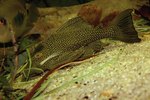
Discus fish are famous for their coloration and infamous for their need for extremely specific water conditions. While some captive-bred discus fish tolerate a wider range of water parameters, the most reliable way to keep discus thriving is to keep their water soft and acidic. Almond leaves can help.
Ideal Water Condition
Discus fish come from several parts of the Amazon drainage. This water starts as rainwater and snow runoff, and thus has little in the way of dissolved minerals. This means the water is very soft. Additionally, the water runs through rain forests, rich with plant life. Decaying plant material like wood releases organic acids called tannins into the water. These acids lower the pH of the river water, making it acidic. The tannins give the water a tea or diluted cola color. In captivity, discus need these conditions replicated, including soft, acidic water. Almond leaves absorb minerals from water and replace them with tannins, mimicking the home water of this species.
How to Use
Do not boil almond leaves. This would completely remove the tannins and defeat their purpose. Different leaves release different amounts of tannins, so there's an element of trial end error. Almond leaves are more potent than other substances that soften and acidify aquarium water, so use them sparingly. Add three to four leaves to the aquarium, wait an hour, then test the pH. You don't want to lower the pH by more than 0.2 per day. If you don't want to look at leaf litter in the aquarium, you can add them to a sump or a filter, out of sight. Replace the leaves as they break down in the aquarium.
Side Effects
The one down side to tea leaves -- or any method of adding tannins -- is that they discolor the aquarium water. Depending on the concentration, this can range from a yellowish tint to water that looks like tea or cola. Some discus hobbyists find this aesthetically pleasing, while others feel it makes the water look dirty. Whatever else it does, it also lowers the pH. While this is the entire point of the leaves, almond leaves may be able to drop the pH too far even for discus fish, so you have to add them slowly and monitor them to avoid crashing the pH too low or too suddenly.
Alternatives
You can use other materials to lower the pH of aquarium water to make it suitable for discus fish. Certain driftwoods, sold in aquarium stores, will lower pH to varying degrees. For example, Malaysian driftwood leaches tannins into the water. To a lesser extent, African driftwood -- aka mopani wood -- has the same effect. You can use dried leaves from the sessile oak, the turkey oak and the European beech. However, make sure you know exactly what tree's leaves you have, since some related trees are poisonous. On a related note, avoid leaves that have been sprayed with pesticides or insecticide. A nylon bag full of peat moss works, but this practice is dying out since peat is beginning to be seen as a finite natural resource.
References
Resources
Photo Credits
-
Medioimages/Photodisc/Photodisc/Getty Images




